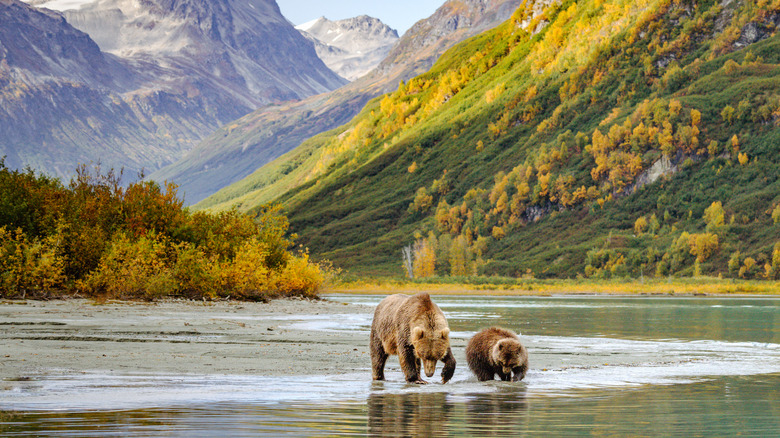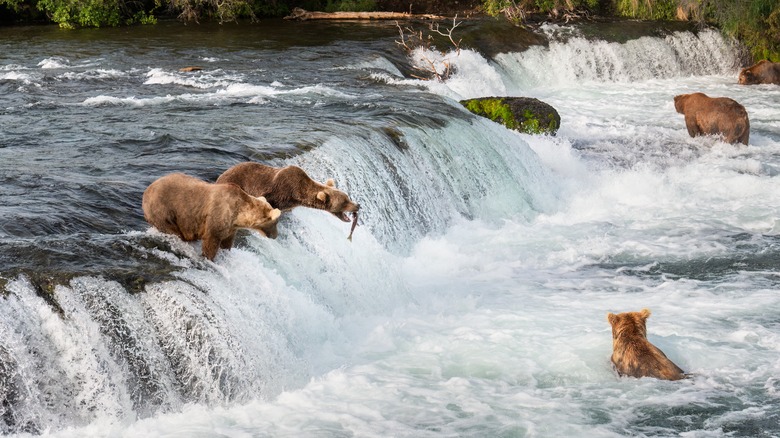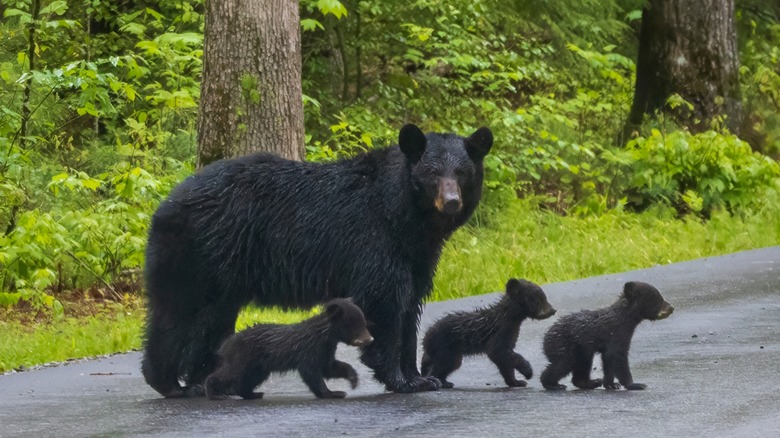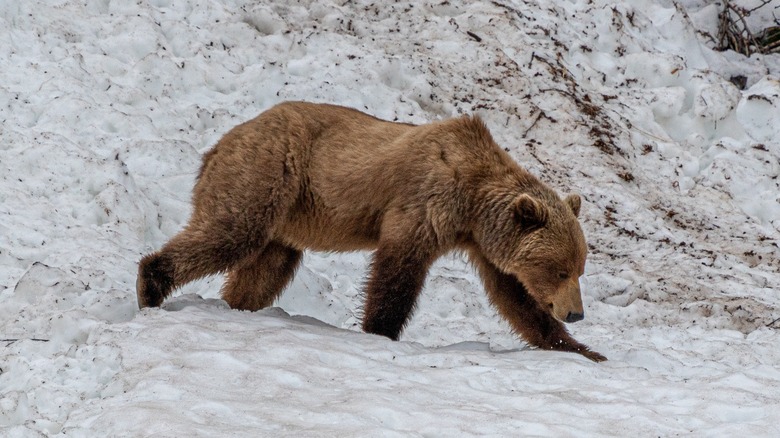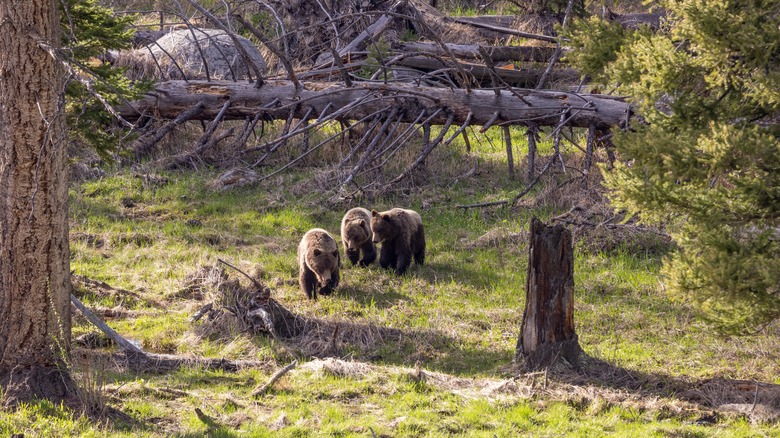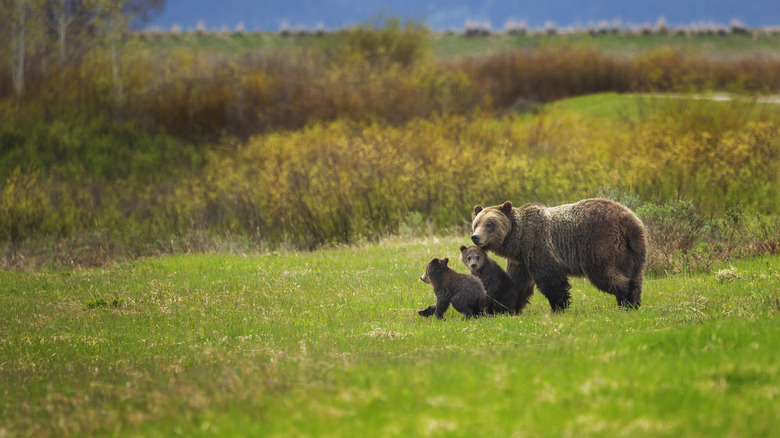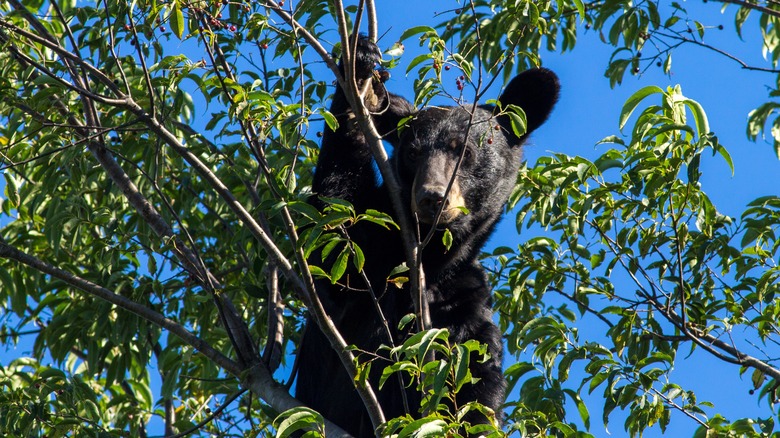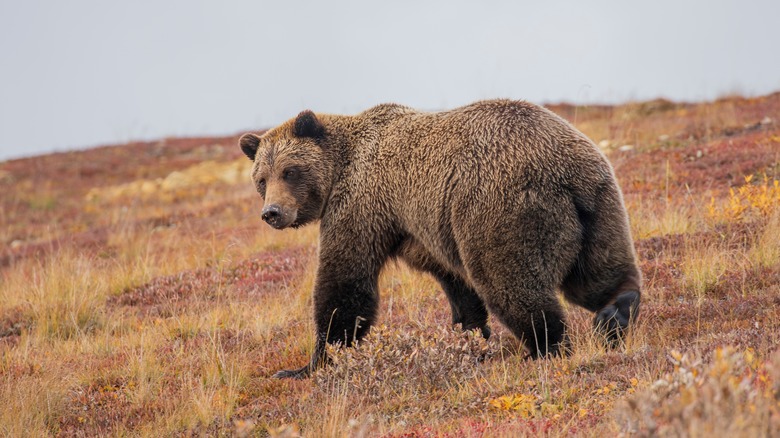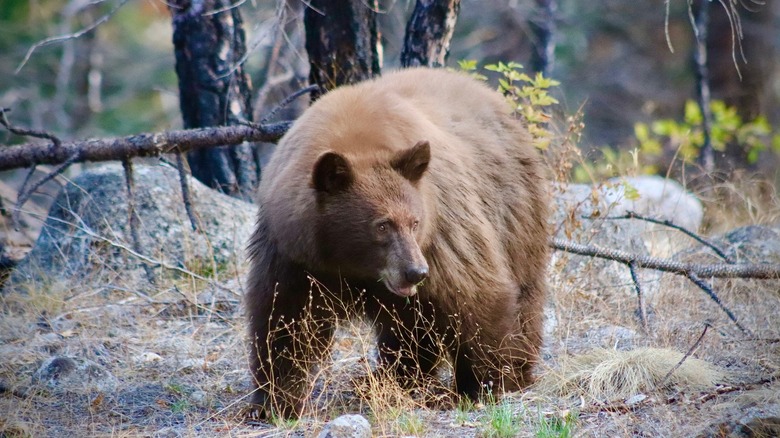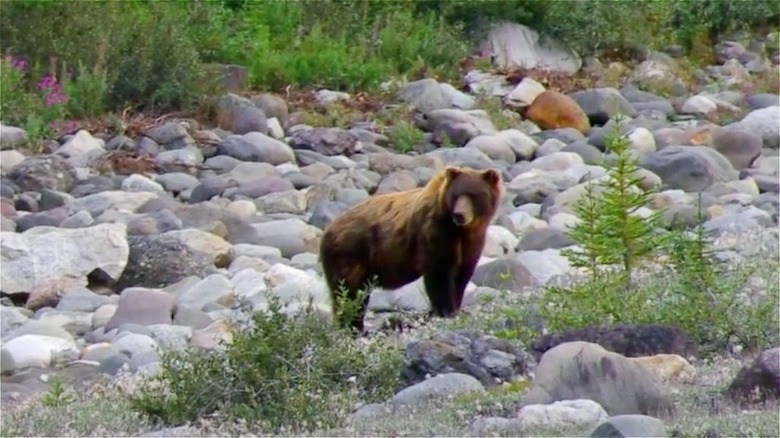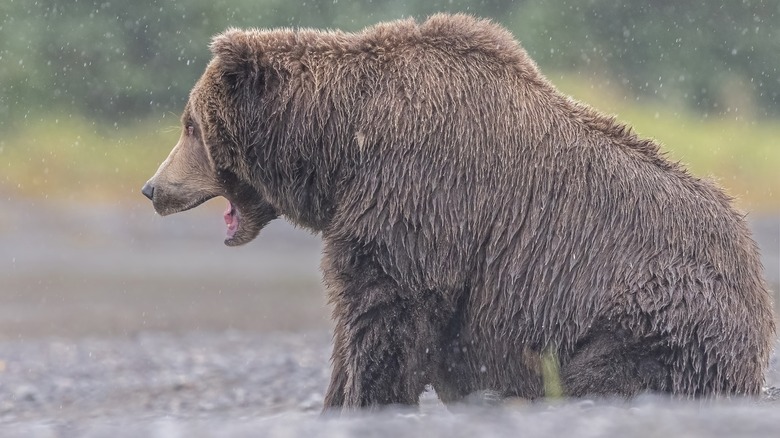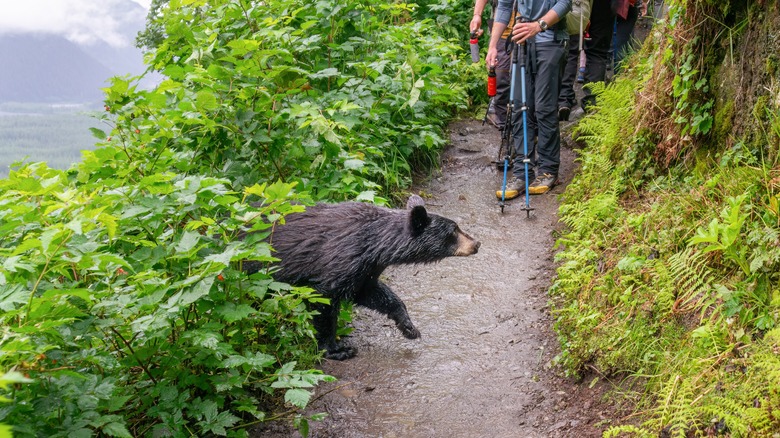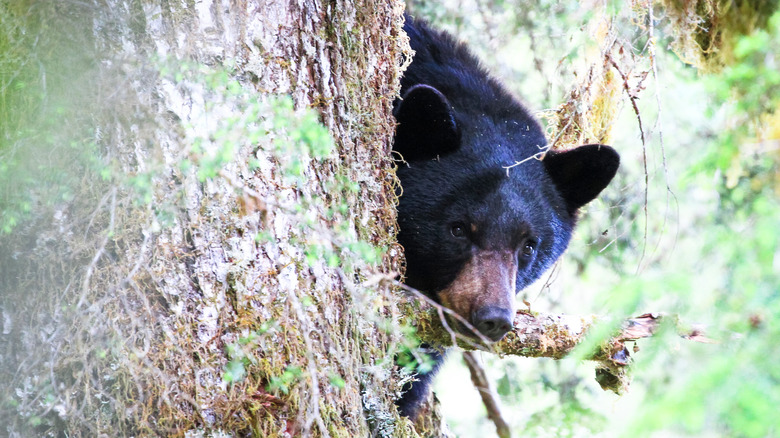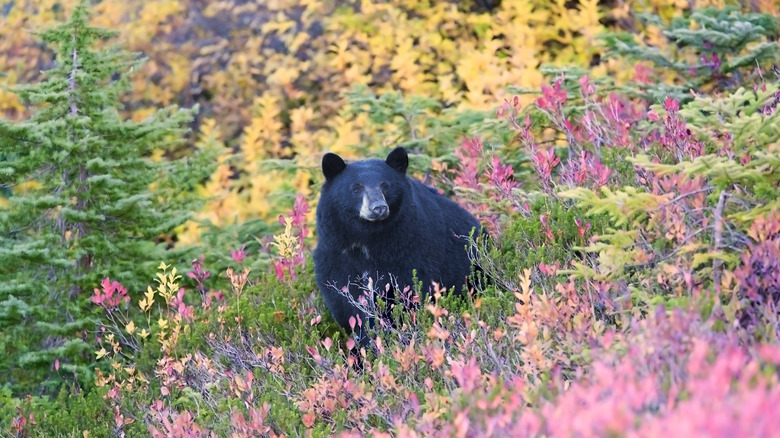13 National Parks For Bear-Watching And Which Ones You Can Spot
Bear-watching has surged in popularity in recent years, offering not just wildlife photographers but also families and casual travelers a thrilling opportunity to observe these powerful creatures in their natural habitats. This rise of ecotourism and wildlife conservation has paved the way for bear-watching to become a significant part of outdoor adventures, drawing millions of travelers to national parks across America.
When you embark on a bear-watching expedition, you may encounter several species native to American national parks. The most common types are black bears and brown bears (grizzlies). In some remote regions, you may even spot the elusive polar bear — though, venturing out in search of this dangerous bear species is not a good idea, given that polar bears view humans as prey. Instead, most bear-watching activities include grizzly and black bears, which are less aggressive species, and more abundant in accessible areas of the United States.
Even though it's not always easy to tell the difference between a grizzly and black bear, each species has its own unique behaviors and habitats. This makes every bear-watching adventure distinct. Plus, there's the added thrill of immersing yourself in stunning natural environments, depending on where you go. So, how do you know where and when to find bears and enjoy a safe, exciting experience? Whether you're hoping to spot a black bear foraging for berries or witness grizzlies fishing for salmon, read on to discover the best national parks for bear-watching, and key tips for observing these magnificent animals responsibly.
Katmai National Park, Alaska
Katmai National Park, located in southern Alaska, is one of the premier destinations for bear-watching in the world. The park is best known for its large population of brown bears. According to the National Park Service, over 2,200 of these animals thrive in the region due to the abundance of salmon in the park's rivers. Each year, thousands of visitors flock to Katmai to witness these magnificent bears in action, particularly at the famous Brooks River and Falls, where bears gather to catch salmon mid-leap during their spawning season.
The best time to visit Katmai for bear-watching is later in the summer and into the fall, when the salmon run is at its peak. At this time, you can observe bears fishing and playing in ways rarely seen elsewhere. Katmai offers a unique close-up experience, but it is still important to avoid making one of the biggest mistakes people make when visiting national parks; that is, disrespecting and encroaching on wildlife. Bears can become aggressive when you infringe on their space, so be sure to use the designated viewing platforms that Katmai has set up to maintain a safe distance.
To experience Katmai's incredible bear-watching opportunities, you need to take a boat or small plane ride from Anchorage, Homer, or Kodiak, since this remote park is not directly accessible via land. Once you're there, you can also ask rangers for insider secrets that they have into bear behavior and ecology. They can also direct you to the Katmai Live Bear Cams, which are strategically positioned at prime viewing locations, so you can have an entertaining and educational experience about bears at Katmai.
Great Smoky Mountains National Park, Tennessee
If you're seeking an accessible and scenic destination for bear-watching, Great Smoky Mountains National Park is one of the best places in the United States for incredible views of black bears in the wild. Known for its mist-covered peaks and biodiverse ecosystem, this park is home to approximately 1,900 black bears, according to the National Park Service. This is a dense population that makes bear-sightings quite common, especially from late spring to early fall. It's also one of the reasons that dogs are not allowed on most of the park's trails, since having your pooch run after a bear is a recipe for disaster.
During the warmer months, bears are most active early in the mornings or late in the evenings, when they forage for food. In the fall, bears prepare for hibernation by consuming large amounts of food, making them more visible.
One of the most popular areas for bear sighting in the Great Smokies is Cades Cove, a scenic loop road where bears are often seen roaming fields or climbing trees. Drive slowly through the valley, keeping your eyes peeled for wildlife. Another route is the Roaring Fork Motor Nature Trail, which passes through dense forests where many hikers on TripAdvisor have reported black bears foraging or wandering along. The highest point in the park, Clingmans Dome offers panoramic views of the Smoky Mountains and is another spot where travelers have encountered bears.
Glacier Bay National Park, Alaska
Alaska's Glacier Bay National Park is a bear-watcher's paradise, offering an untamed wilderness with breathtaking glaciers, pristine waterways, and a rich diversity of wildlife. The park is home to both brown and black bears, giving visitors the unique opportunity to spot both species.
In late spring and early summer, bears are often seen along the shoreline, foraging for food. Bartlett Cove, located near the park's entrance, is one of the more accessible areas to witness these bears in action in the early mornings or late afternoon.
In late summer, visitors can see bears gathering near streams to fish for salmon. One of the best ways to experience this is by boat. Not only can you view the glaciers in all their majesty as you cruise along the shorelines, it's common to see bears searching for food, swimming, or wandering by the glaciers. Beardslee Islands, a popular area that kayakers paddle through, is known for frequent black bear sightings as bears forage by the water's edge. While in the water, it's important to maintain a safe distance from bears, too. Bears are great swimmers and can attack if provoked.
Yellowstone National Park, Wyoming
As the first national park in the world, Yellowstone is synonymous with wildlife watching, and bear encounters are a huge part of that allure. With well-maintained roads and scenic viewpoints, Yellowstone allows for relatively easy access to both black and brown bear-watching spots without the need for strenuous hiking, either.
Lamar Valley is a hotspot for grizzly bear sightings, as the wide-open landscape provides excellent visibility for bear-watching. Hayden Valley is another prime location. It offers a mix of forests, rivers, and meadows. Near the Yellowstone River is a great spot to see grizzly bears — which are a few of the creatures you should beware of when adventuring in Yellowstone National Park. The Tower-Roosevelt Area has also seen a large number of reports of black bear sightings. As you drive along the roads in this region of the park, keep an eye out along the treeline and you may spot some foraging bears.
Prime bear-watching season at Yellowstone starts in May and June, when bears emerge from hibernation and begin foraging for food. Grizzlies, especially, are active during this time. Fall is another great time as bears forage along roadsides and open meadows. Yellowstone also boasts a comprehensive bear management program which focuses on conservation, research, and education. Check out their ranger talks, demonstrations, and guided walks for a fruitful bear-watching experience.
Grand Teton National Park, Wyoming
Compared to its famous neighbor, Yellowstone, Grand Teton National Park offers a more intimate and less crowded experience. But, it's no less thrilling. In the shadow of the Teton Range, right in the middle of bear country, the park is home to both black and grizzly bears, which are best spotted from spring through fall.
Popular areas for bear-watching include Willow Flats, located near Jackson Lake, which is known for frequent grizzly bear sightings, and Signal Mountain, where bears are often spotted foraging in the meadows. The Oxbow Bend of the Snake River is another prime location, where bears come down to fish. During prime bear-watching season, bears are also likely to be seen near roads and trails as they venture further for food, making viewing opportunities very accessible.
What sets Grand Teton apart is the combination of its breathtaking landscapes and its proximity to wildlife. Watching a bear roam beneath the jagged peaks of the Teton Range is an awe-inspiring experience.
Shenandoah National Park, Virginia
Thanks to Shenandoah's thriving population of black bears, bear-watching is one of the park's highlights. According to the Shenandoah National Park Trust, there are over 200,000 acres of protected land in Virginia's Blue Ridge Mountains in this park. Shenandoah provides the perfect setting for encountering these magnificent creatures.
Shenandoah also has a slightly longer window of opportunity to watch bears. April through October is when bears roam hungry along the park's 500+ miles of trails. Prime locations include the Big Meadows area, where open fields often attract bears in the early morning and late afternoon. Along the park's Skyline Drive, a 105-mile scenic route, visitors have reported on TripAdvisor spotting black bears from their cars. It makes for a safe and comfortable viewing experience.
For those who prefer hiking, trails like the Dickey Ridge and Hawksbill Summit offer chances for more intimate encounters along the forested paths. The Dickey Ridge Trail is accessible from the northern entrance of the park, and is relatively easy, making it a great climb for families and casual hikers. The Hawksbill Summit Trail, which leads to the highest point in Shenandoah, is a more strenuous climb that takes you through dense thickets and rocky outcrops, but these varied habitats increase the likelihood of bear sightings.
Denali National Park, Alaska
Denali National Park is renowned for its strong emphasis on conservation. The park's remote Alaskan location, limited road access and vast landscapes provide a sense of solitude, allowing visitors to connect with nature and witness wildlife in an undisturbed setting.
The 92-mile Denali Park Road is the main access route for visitors and also provides the best opportunities for bear sightings. Along the road, Sable Pass and Igloo Canyon are prime spots to look for bears. At the end of Denali Park Road, Wonder Lake is a picturesque spot with incredible views of Denali and reported bear sightings. There is a campground near Wonder Lake as well, slated to reopen in summer of 2026 as of this writing, where bears can be spotted in the early hours. If you want to get active, the Savage River Loop Trail is a relatively easy hike that winds along a river where bears often forage along the banks. There is also a bridge which offers a great vantage point from above.
For those without a car, The Toklat River area is accessible by park bus and is a hotspot for bear activity too. Consider joining a guided tour for expert knowledge while catching a glimpse of bears in action.
Sequoia National Park, California
In California's Sierra Nevada Mountain Range, Sequoia National Park is a prime location for bear sightings. The Giant Forest is a particularly noteworthy area. It offers many popular viewpoints and panoramic vistas, as well as opportunities to see black bears in the meadows below.
Another great spot is Lodgepole Village, which serves as a convenient base for exploring the park and is surrounded by a prime bear habitat. The Lodgepole Campground often gets high reports of bears wandering through, along with the Lodgepole Trail. Crescent Meadow is another lush area that attracts wildlife. It is an easy loop to hike while watching bears forage for berries and grass. Visitors can also enjoy the historical significance of Tharp's Log, a nearby log cabin that offers a quiet spot to sit and watch bears, in the quiet hours of the morning.
For those looking to camp, the Buckeye Flat Campground offers a serene setting along the Kaweah River and is surrounded by nature. Because the campground has high levels of reported bear activity, it is important to store your food correctly while camping here, and the campsite offers large food storage lockers that are resistant to bears.
Wrangell-St. Elias National Park, Alaska
Wrangell-St. Elias National Park is the largest national park in the United States, spanning over 13 million acres of stunning, rugged wilderness in Alaska. In the summer and fall, visitors get to watch bear packs walk freely through the vast untouched lands. Since bears are prominent in this area, correct food storage is mandated all throughout the park for visitors' and bears' safety.
The small towns of McCarthy and Kennecott serve as gateways to the park — and they are smack dab in the middle of bear country. Hike along the Kennecott Trails, which yield bear sightings during the early mornings or late evenings. If you do encounter a bear, do not approach it. While bears don't typically attack humans, in remote areas, where help may be limited, you want to be safe rather than sorry. Carry bear spray to make sure you know what to do if you are attacked by a bear.
In the park, guided tours to the Root Glacier often lead to bear sightings, since there are many berries in this area. But the real gem at Wrangell-St. Elias are the opportunities to see bears fishing for salmon. With its numerous waterways, there are many prime spots for bear activity. The Copper River Delta is a prime viewing location for this, particularly during the summer months, with its expansive landscapes for bears to roam free.
Lake Clark National Park, Alaska
Alaska really takes the cake with the most number of bear-watching viewpoints. Add Lake Clark National Park to the list, which is renowned for its impressive population of brown bears. Covering over 4 million acres, visitors can observe bears against the backdrop of majestic mountains, pristine lakes, and lush forests.
Silver Salmon Creek is known for its high concentration of brown bears — and guess why? Visitors often see bears fishing for salmon in the creek. Guided tours are available, allowing for safe viewing experiences from designated platforms along the creek. Chinitna Bay offers stunning views of the surrounding mountains and coastline, but here bears frequently wander the beaches in search of food, making it an ideal spot for sightings, especially during low tide. Boat tours around the Bay are a great way to view bears from the water while enjoying the park's scenic beauty.
Lastly, Lake Clark is the park's namesake and provides a tranquil setting for bear-watching. Visitors can kayak or boat around the lake for the chance to be rewarded with unique viewing opportunities.
Kenai Fjords National Park, Alaska
Located in Alaska's stunning Kenai Peninsula, Kenai Fjords National Park is a breathtaking destination where icy fjords meet rich marine environments. The park is widely known for its glaciers, but it is also home to black and brown bears.
Similar to Lake Clark, many of Kenai's prime bear-viewing spots are accessible from the water. Aialik Bay, a highlight of this park, is accessible only by boat. Tours through the Bay will allow visitors to see bears, but also potentially sea otters, seals, and whales, making for a memorable and exciting wildlife experience!
The Resurrection River and the trail leading up to it, where salmon spawn in the summer brings bears to its riverbanks, when it gets warmer. The area around the Harding Icefield is also worth exploring. Though it is more remote, it supports a diverse ecosystem, attracting bears that roam the meadows in search of food. It is actually these parts of the park that make for incredible wilderness adventures.
Olympic National Park, Washington
In the Pacific Northwest, Olympic National Park is home to black bears. As the snow melts, spring and summer pave the way for roaming bears all throughout the park. Early summer is particularly exciting, as mother bears with subs are often seen in the meadows.
The Hoh Rain Forest, Hurricane Ridge, Elwha Valley, Enchanted Valley, and Sol Duc Valley, known for their lush greenery and towering trees, are excellent areas for bear-watching. There are numerous easy trails, like the Olympic Hot Springs that hikers can walk through. When the trees are flush with berries during the warmer months, bears can be spotted munching on these delicious treats. For clearer, unobstructed views, check out the alpine meadows at Hurricane Ridge, where bears forage for wildflowers and other vegetation over the summer.
Olympic National Park also offers information about bear behavior and ecology at their Visitor Center. In the surrounding area, many visitors have reported seeing bears, too!
North Cascades National Park, Washington
Often referred to as the "American Alps" due to its dramatic peaks, glaciers, and deep valleys, North Cascades National Park is a haven for outdoor enthusiasts and wildlife lovers alike (via National Geographic). The park is home to many black bears, making it a prime destination for those looking to observe these magnificent creatures without the distractions that come with large crowds. Occasionally, there have been reports of grizzlies here, too.
Before even getting into the park, the area around Lake Chelan, an entryway to the park, provides great opportunities to see bears along the shores. Inside the park, August is a fantastic time to see bears foraging in the meadows and along trails, as they prepare for the upcoming hibernation season.
The Cascade Pass and Sourdough Mountain Trail are popular hiking trails where bears are often spotted. Along these trails, hikers can enjoy breathtaking views while keeping an eye out for black bears lumbering through forests.
